Hominy vs. Masa — What's the Difference?

Difference Between Hominy and Masa
ADVERTISEMENT
Compare with Definitions
Hominy
Hominy is a food produced from dried maize (corn) kernels that have been treated with an alkali, in a process called nixtamalization (nextamalli is the Nahuatl word for "hominy"). "Lye hominy" is a type of hominy made with lye.
Masa
Masa (or masa de maíz) (English: ; Spanish pronunciation: [ˈmasa]) is a maize dough that comes from ground nixtamalized corn. It is used for making corn tortillas, gorditas, tamales, pupusas, and many other Latin American dishes.
Hominy
Coarsely ground corn (maize) used to make grits
Hominy grits
Masa
Dough made of dried corn that has been soaked in limewater then rinsed and ground, used especially in tortillas and tamales.
Hominy
Whole or ground kernels of corn from which the hull and germ have been removed, as by boiling in a solution of water and lye.
ADVERTISEMENT
Masa
(US) maize dough made from freshly prepared hominy, used for making tortillas, tamales, etc.
Hominy
A food made from hulled corn (maize) kernels soaked in lye water, rinsed, then cooked and eaten; or, the rinsed kernels are dried and coarsely ground into hominy grits.
Masa
An independent group of closely related Chadic languages spoken in the area between the Biu-Mandara and East Chadic languages
Hominy
Maize hulled and broken, and prepared for food by being boiled in water.
Hominy
Hulled corn with the bran and germ removed
Share Your Discovery

Previous Comparison
Nice vs. Nicely
Next Comparison
Cannellini vs. Cannelloni













































